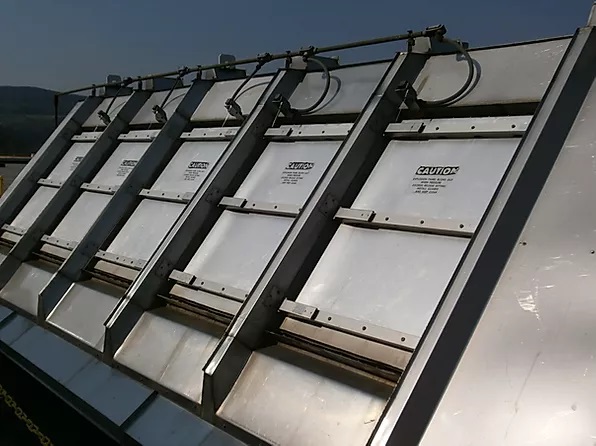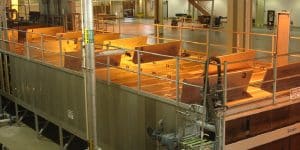Many manufacturing processes involve high amounts of heat and pressure.  Naturally, that poses a safety risk to your facility, so it’s vital to invest in failsafes to keep everyone safe and make sure processes continue with minimal interruptions. One way to do this on high-pressure equipment is with the use of explosion relief doors.
Naturally, that poses a safety risk to your facility, so it’s vital to invest in failsafes to keep everyone safe and make sure processes continue with minimal interruptions. One way to do this on high-pressure equipment is with the use of explosion relief doors.
Explosion doors often represent a significant investment, but the investment can be well worth it.
Factors that Affect Explosion Door Costs
Typically, explosion relief doors range in price from $5,000 to $15,000 per door. However, the exact cost will vary depending on a number of factors based on your working environment and applications. Some of the factors involved include the following.
The materials needed
One factor is the materials used in the door and its components. Different applications require different types of materials. For instance, stainless steel is needed for processes that involve lots of moisture, whereas high carbon steel may be more appropriate for heavy-duty environments.
Door size
The door size also has an impact on the cost. Typically, the larger the door, the more expensive it will be since it requires more material—and more consistent quality throughout that material—to produce.
Number of explosion events
Explosion relief doors are best for environments with somewhat frequent explosion events. While they will last longer than a single event (unlike rupture discs), they can still wear out over time. At some point, they will need to be repaired or replaced, and they’ll require regular upkeep as well in order to keep them in working condition. The harsher the environment, the higher maintenance and replacement costs will be.
Special options
Additional options may be added on to explosion doors to help match the production environment. Options such as limit switches, safety cages, special paint or coatings, additional access ports, retaining cables, adjustments to the shape and size, and the like can all drive up the cost.
Cost of Explosion Relief Doors Vs. Rupture Discs
When it comes to preventing damage from explosions, rupture discs are another option that many manufacturers choose. They may be cheaper than explosion doors upfront, but they’re not necessarily more cost-effective, especially since they’re only good for one use. After rupturing, they have to be replaced.
Upfront costs
Many manufacturers opt for rupture discs because they have a smaller upfront cost than explosion relief doors. On average, an explosion door may cost two or three times the price of a rupture disc, though that difference actually diminishes as size increases. A larger door may only be about 50% more than a rupture disc used in the same application.
Cost efficiency
While rupture discs may be appropriate for small scale applications with very few explosion events, they tend to be less cost-effective in more expansive, high-risk processes. The cost of replacing ruptured explosion vents can add up over time, making explosion doors more cost efficient in applications that face such events often.
On the other hand, if a facility goes ten years without any explosions, then a rupture disc would likely be more efficient since there’s less of an upfront cost involved.
Range of applications
Explosion doors can be made to match a wider range of applications. Rupture discs are typically limited in the kinds of metals that can be used, and certain applications require specific types of materials in order to be safe.
On the other hand, explosion doors can be made from a wide range of metals, from 304 and 316 stainless steel to aluminum, making them easily adaptable to any process. They can also be made in a variety of shapes and sizes, from small vents to full-size doors that allow personnel access.
Cost Benefits of Explosion Doors
While explosion doors can be expensive starting out, they offer a number of potential cost benefits to manufacturers. Some of the key benefits include the following.
Reduced downtime
When a rupture disc fails, it needs to be replaced, and the time that takes can lengthen downtime from an explosion event. Since explosion doors are intended to close back up on their own after an explosion event, they typically result in less downtime than rupture discs would—and certainly less than having no failsafe at all.
While it’s true that regular maintenance is needed to keep explosion relief doors in working shape, that work can be scheduled for times outside of normal operating hours, meaning it has little impact on equipment uptime as long as you have a decent maintenance management process in place.
Improved safety
By releasing pressure from an explosion, there’s less risk of equipment actually exploding during production, which is naturally safer for operators on site. In addition, the fact that explosion relief doors automatically shut after an event reduces any fumes that may be released into the work environment as well.
Less damage from explosion events
Finally, explosion doors reduce overall damage from explosion events. Pressure is released safely rather than violently, keeping damage to a minimum. This is especially important in processes that experience somewhat frequent explosions since it helps equipment last longer and keeps repair costs down.
Determining the Cost of Explosion Doors for Your Facility
Ultimately, the cost of explosion relief doors comes down to your applications, the frequency of explosion events, the efficacy of your maintenance process, and other environmental factors. To get started figuring out the cost of explosion doors in your facility, it’s best to talk to a manufacturer who can produce them to your specifications.






 Contract
Contract Food & Bev
Food & Bev